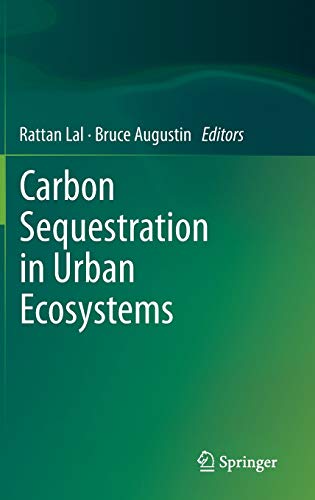Verwandte Artikel zu Carbon Sequestration in Urban Ecosystems

Zu dieser ISBN ist aktuell kein Angebot verfügbar.
Alle Exemplare der Ausgabe mit dieser ISBN anzeigen:Rapid urbanization started since early 1950s. Among numerous consequences of urbanization are change in landuse and land cover including deforestation, encroachment of prime farmland, and alterations in landscape. These consequences reduce the ecosystem carbon stocks especially in biota and soils, alter the hydrologic cycle by increasing runoff and decreasing soil water storage, change energy budget by altering albedo, and disrupt cycling of carbon and other elements. Such drastic alterations in land use and land cover and biogeochemical cycling of C and other elements affect global climate at local, regional and global scales because of drastic and irreversible changes in the structure, functions and dynamics of ecosystems. The global urban expansion rate is estimated at ~2 million ha (Mha) of additional land to accommodate annual population growth of 70 to 80 millions. Because urban areas consist of build up areas and green areas or free space, judicious management of free space is crucial to moderating the global carbon cycle. Open spaces can be sustainably managed for home lawns, sports grounds, recreational areas, forests, and urban agriculture. Green roofs are also important in influencing the albedo and the carbon and hydrologic cycles. The strategy is to increase the green space areas, enhance their net primary productivity, and increase the overall carbon budget of urban ecosystems. It is also important to link science with policy.
„Über diesen Titel“ kann sich auf eine andere Ausgabe dieses Titels beziehen.
- VerlagSpringer
- Erscheinungsdatum2011
- ISBN 10 9400723652
- ISBN 13 9789400723658
- EinbandTapa dura
- Anzahl der Seiten400
- HerausgeberLal Rattan, Augustin Bruce
Neu kaufen
Mehr zu diesem Angebot erfahren
Versand:
EUR 32,99
Von Deutschland nach USA
Beste Suchergebnisse beim ZVAB
Carbon Sequestration in Urban Ecosystems
Buchbeschreibung Buch. Zustand: Neu. Druck auf Anfrage Neuware - Printed after ordering - Urbanization drastically alters the ecosystems structure and functions, disrupts cycling of C and other elements along with water. It alters the energy balance and influences climate at local, regional and global scales. In 2008, urban population exceeded the rural population. In 2050, 70% of the world population will live in urban centers. The number of megacities (10 million inhabitants) increased from three in 1975 to 19 in 2007, and is projected to be 27 in 2025. Rapid urbanization is altering the ecosystem C budget. Yet, urban ecosystems have a large C sink capacity in soils and biota. Judicious planning and effective management can enhance C pool in urban ecosystems, and off-set some of the anthropogenic emissions. Principal components with regards to C sequestration include home lawns and turfs, urban forests, green roofs, park and recreational/sports facilities and urban agriculture. Rapid urbanization started since early 1950s. Among numerous consequences of urbanization are change in landuse and land cover including deforestation, encroachment of prime farmland, and alterations in landscape. These consequences reduce the ecosystem carbon stocks especially in biota and soils, alter the hydrologic cycle by increasing runoff and decreasing soil water storage, change energy budget by altering albedo, and disrupt cycling of carbon and other elements. Such drastic alterations in land use and land cover and biogeochemical cycling of C and other elements affect global climate at local, regional and global scales because of drastic and irreversible changes in the structure, functions and dynamics of ecosystems. The global urban expansion rate is estimated at ~2 million ha (Mha) of additional land to accommodate annual population growth of 70 to 80 millions. Because urban areas consist of build up areas and green areas or free space, judicious management of free space is crucial to moderating the global carbon cycle. Open spaces can be sustainably managed for home lawns, sports grounds, recreational areas, forests, and urban agriculture. Green roofs are also important in influencing the albedo and the carbon and hydrologic cycles. The strategy is to increase the green space areas, enhance their net primary productivity, and increase the overall carbon budget of urban ecosystems. It is also important to link science with policy. Artikel-Nr. 9789400723658
Weitere Informationen zu diesem Verkäufer | Verkäufer kontaktieren

